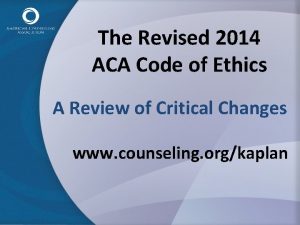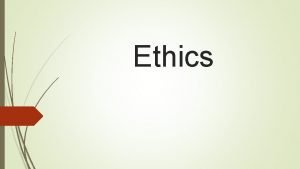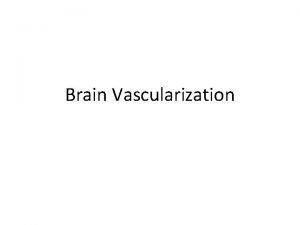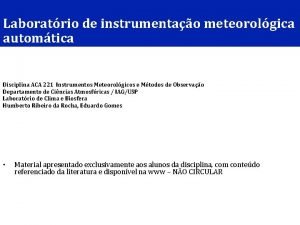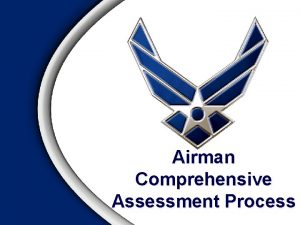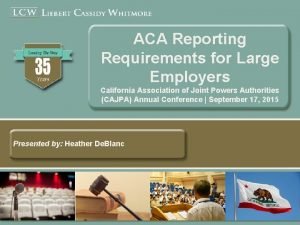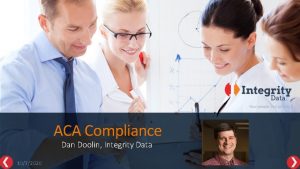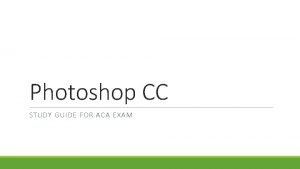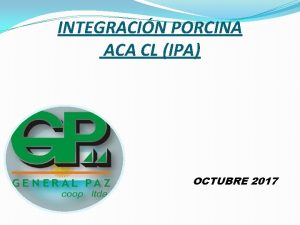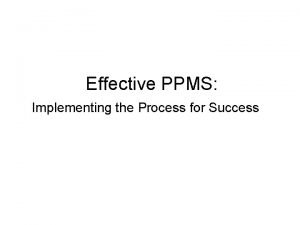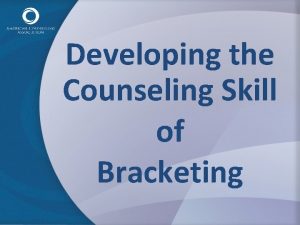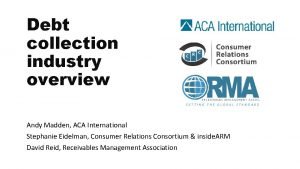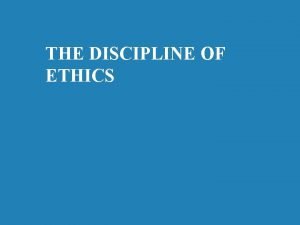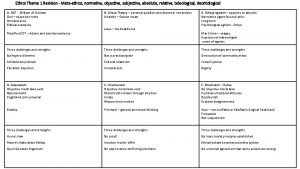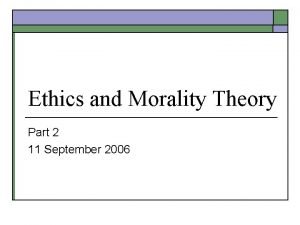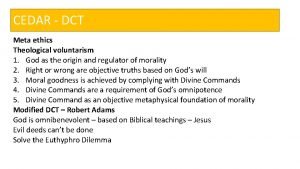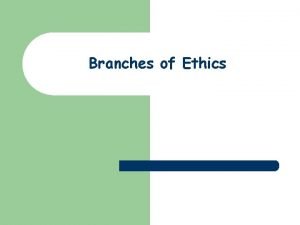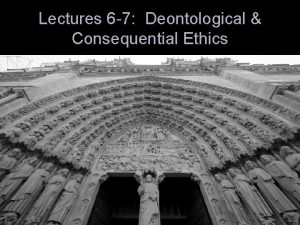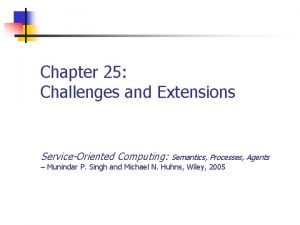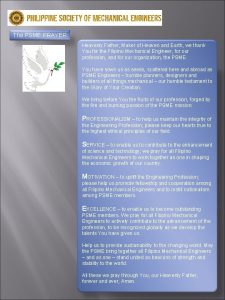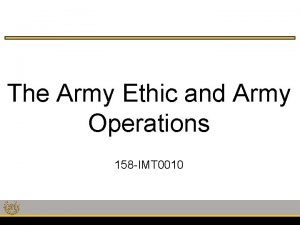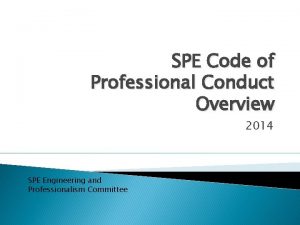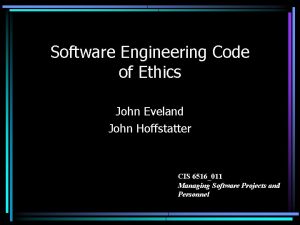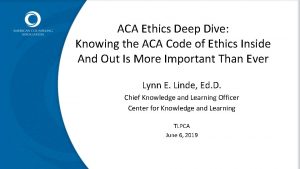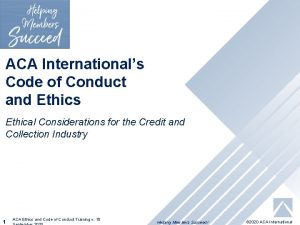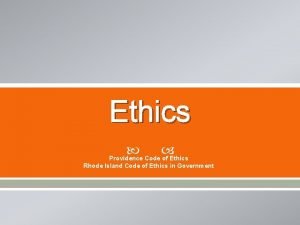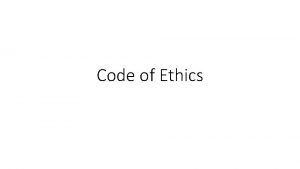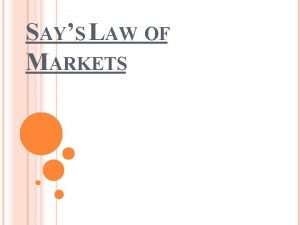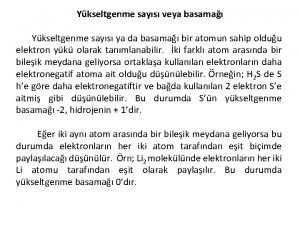The ACA Code of Ethics Says What Everything







































- Slides: 39

The ACA Code of Ethics Says What? Everything You Need to Know to Practice Ethically Lynn E. Linde, Ed. D. Chief Knowledge and Learning Officer Center for Knowledge and Learning TLPCA June 7, 2019

Objectives: Participants will: 1. Understand the importance of ACA Code of Ethics and the information contained in the Code; 2. Understand how the Code directs and impacts practice; and 3. Become knowledgeable about how to make ethical decisions.

Key concept • The 2014 COE clarifies what was always in the Code of Ethics and puts the welfare of the client first.

The 2014 ACA COE • Applies only to counselors in fulfilling their professional responsibilities with clients, students, supervisees, research subjects, and when consulting.

Preamble • Definition of counseling: Counseling is a professional relationship that empowers diverse individuals, families and groups to accomplish mental health, wellness, education, and career goals. • The preamble has 2 parts, both of which are new to the 2014 COE: – Professional values – Ethical principles

Professional Values 1. Enhancing human development through the lifespan; 2. honoring diversity and embracing a multicultural approach in support of the worth, dignity, potential and uniqueness of people within their social and cultural contexts; 3. promoting social justice; 4. safeguarding the integrity of the counselor-client relationship; and 5. practicing in a competent and ethical matter.

Ethical Values • • • Autonomy Nonmaleficence Beneficence Justice Fidelity Veracity (new 2014)

COE Purpose • The Code: 1. sets forth the ethical obligations of ACA members and provides guidance intended to inform the ethical practice of professional counselors; 2. identifies ethical considerations relevant to professional counselors and counselors-in-training; 3. enables the Association to clarify for current and prospective members, and for those served by members, the nature of the ethical responsibilities held in common by members;

The Code, continued 4. serves as an ethical guide designed to assist members in constructing a course of actions that best serves those utilizing counseling services and establishes expectations of conduct with a primary emphasis on the role of the professional counselor; and 5. helps support the mission of ACA. The standards contained in this Code serve as the basis for processing inquiries and ethics complaints.

Section A: The Counseling Relationship • Records and documentation • Avoiding harm and imposing values • Prohibits non-counseling roles and relationships • Managing and maintaining boundaries and professional relationships • Unacceptable business practices – fee splitting • Termination and referral

Termination and Referral • A. 11. b Counselors refrain from referring prospective and current clients based solely on the counselor’s personally held values, attitudes, beliefs, and behaviors. Counselors respect the diversity of clients and seek training in areas in which they are at risk of imposing their values onto clients, especially when the counselor’s values are inconsistent with the client’s goals or are discriminatory in nature.

Section B: Confidentiality and Privacy • Exceptions (to confidentiality) • Records and documentation • Case consultation

Section C: Professional Responsibility • Competence • Consultations and ethical obligations • Nondiscrimination • Treatment modalities

How do we define competence? • Lack of competence is based on several factors and is specific to each counselor: – Scope of practice of credential held by the counselor – Education, training and experience of the counselor – Setting in which the counselor practicing – scope of work • May refer when a higher level of practice is needed than the counselor is able/qualified to provide • Does not include lack of knowledge/skills/information about any client characteristic – must educate self, seek supervision, consultation

Competence

C. 5 Nondiscrimination • Counselors do not condone or engage in discrimination against prospective or current clients, students, employees, supervisees, or research participants based on age, culture, disability, ethnicity, race, religion/spirituality, gender identity, sexual orientation, marital/partnership status, language preference, socioeconomic status, immigration status, or any basis proscribed by law.

Section D: Relationships with other professionals • Relationships with colleagues, employers, and employees • Provision of consultation services

Section E: Evaluation, Assessment, and Interpretation • Assessment • Diagnosis of mental disorders • Forensic evaluation: Evaluation for legal proceedings

Section F: Supervision, Training and Teaching • Supervisory relationship and supervisor responsibilities • Responsibilities of counselor educators • Student welfare • Evaluation and remediation, gatekeeping • Roles and relationships between counselor educators and students • Multicultural/diversity competence in counselor education and training programs

Section G: Research and Publication • Research responsibilities • Managing and maintaining boundaries • Publications and presentations

Section H: Distance Counseling, Technology, and Social Media • Knowledge and legal considerations • Informed consent and security • Client verification • Distance counseling relationship • Records and web maintenance • Social media

Section I: Resolving Ethical Issues • Standards and the law • Ethical decision making models • Suspected violations • Cooperation with ethics committees

Boundaries: What are they? • Boundaries are the frame around the relationship that helps define the roles of the participants in therapeutic relationship – Helps the participants know what to expect – Helps provide consistency in therapeutic relationship • Issues involving boundaries are variable and depend on the people involved and the situation – Not static; may change – Situational – Many types of boundaries • Critical to be aware how they impact the counseling relationship

Boundary crossings versus violations • Boundary crossing: a departure from a normally accepted way of doing things to benefit the client; it is situational • Boundary crossings: – Often discuss using terms such as dual relationships, beneficial vs. harmful behaviors, extending relationships beyond conventional boundaries

Crossing boundaries • Boundary crossings, continued – Need to examine why there is a need to cross the boundary – Need to weigh the potential harm to the client against the potential benefits – Are you consistent in your boundaries? Would you do this same thing for another client in similar circumstances? – Is the behavior an accepted part of your workplace • Boundary violation: a serious breach that causes harm

Crossing boundaries • Occasional or some boundary crossings can be justified if there is benefit to the client and little risk of harm • But frequent crossings may place the practitioner at risk.

Ethical Decision Making • When counselors are faced with an ethical dilemma, they use, and document as appropriate, an ethical decision making model. • A number of models exist and more continue to be created. • No one model is more effective than others. • Some models may be more useful in certain situations that others.

Forrester-Miller and Davis Model 2016 1. Identify the problem. 2. Apply the ACA Code of Ethics. 3. Determine the nature and dimensions of the dilemma. 4. Generate potential courses of action. 5. Consider the potential consequences of all options and determine a course of action. 6. Evaluate the selected course of action. 7. Implement the course of action.

Infographic

HPSO 2019 Report Key Findings • • 2014 Report (10 years of data): 1, 043 adverse incidents and claims reported 2019 Report (5 years of data): 5, 626 adverse incidents and claims reported • Top finding: sexual misconduct and allegations of multiple relationships with clients despite the potential for client harm increased in severity • Increase in closed cases of allegations of failure to practice within boundaries of competence • Failure to maintain minimal professional standards, sexual misconduct, breach of confidentiality, and reporting to third parties highest distribution of license protection paid claims

JCD article Wilkinson, T. , Smith, D. , & Wimberly, R. (2019). Trends in ethical complaints leading to profession counseling licensing boards disciplinary actions. Journal of Counseling and Development (97), 98 -104. DOI: 10. 1002 cad/12239. • • Surveyed state licensing boards in all states and DC for data 2010 -2014 Looked at nature of complaints against counselors licensed to practice independently that resulted in disciplinary action #1 – Continuing education violations (16. 8%) #2 – Nonsexual dual relationships (12. 5%) #3 – Sexual relationships (9%) #4 – Misrepresenting credentials (6. 7%)

Most frequent ACA Ethics consultations 1. Boundaries 2. Social media 3. Distance counseling 4. Supervision 5. Private practice 6. Minors and consent issues 7. Subpoenas and testimony 8. Counseling records 9. Licensure and scope of practice 10. Mandated and other reporting

Ethics Resources • https: //www. counseling. org/knowledge-center/ethics/code-of-ethicsresources • Counseling Today Ethics columns • Webinars • Podcasts • Decision making models • Infographic • Books • Other resources

Only I can save my client! • And other faulty thinking: – Practitioner may not be fully aware that own behavior is a boundary crossing – Normalization of deviance – Boundary crossings are the primary reason for referral for discipline/ethics committees – Whose needs are you meeting? – When is doing more enough?

Only I can save my client! And more…. – Need to look at client autonomy and the client’s right to choose; sometimes helping involves letting our clients fail – Is what you are doing a standard practice? – Would you do this for everyone or only for this client? – What happens if you don’t help this time? – Is your help actually enabling?

Safeguards • • • Obtain the client’s informed consent Seek consultation Engage in discussion with the client Document, document…. Self monitor Obtain supervision

Words of Wisdom • Just because it’s not in there (COE), doesn’t mean you can • Just because you can, doesn’t mean you should. • It’s a slippery slope… • It’s lonely out there…


Contact information Lynn E. Linde llinde@counseling. org
 Aca code of ethics 2014
Aca code of ethics 2014 Aca code of ethics 2019
Aca code of ethics 2019 Code commit code build code deploy
Code commit code build code deploy Management information aca
Management information aca Posterior inferior cerebellar artery
Posterior inferior cerebellar artery Aca mission
Aca mission Ventrikel ct scan
Ventrikel ct scan Aca 221
Aca 221 Airman's critical role in support of the mission
Airman's critical role in support of the mission California aca reporting requirements
California aca reporting requirements Aca territory stroke
Aca territory stroke Pcc advising
Pcc advising Cupido es un murciélago capítulo 1
Cupido es un murciélago capítulo 1 Sawtooth conjoint
Sawtooth conjoint Dan doolin
Dan doolin Past participle
Past participle Photoshop study guide
Photoshop study guide Imiesłów
Imiesłów Aca student liability insurance
Aca student liability insurance Aca.cl
Aca.cl Aca international certification
Aca international certification Ethical bracketing
Ethical bracketing Aca international certification
Aca international certification Aca 100
Aca 100 Descriptive ethics
Descriptive ethics Realism vs anti realism
Realism vs anti realism What is micro-ethics
What is micro-ethics Aspects of honesty
Aspects of honesty Methaethics
Methaethics Descriptive ethics vs normative ethics
Descriptive ethics vs normative ethics Discipline
Discipline Meta ethics vs normative ethics
Meta ethics vs normative ethics Methaethics
Methaethics Teleological ethics vs deontological ethics
Teleological ethics vs deontological ethics Teleological ethics vs deontological ethics
Teleological ethics vs deontological ethics Psme code of ethics
Psme code of ethics Code of conduct army
Code of conduct army Welcher code
Welcher code Spe code of ethics
Spe code of ethics Software engineering code of ethics
Software engineering code of ethics
